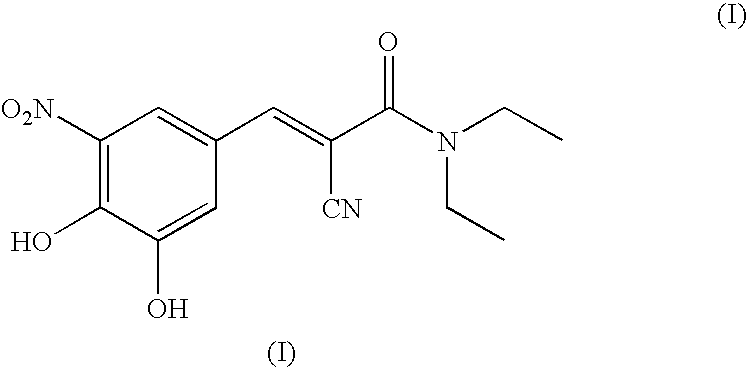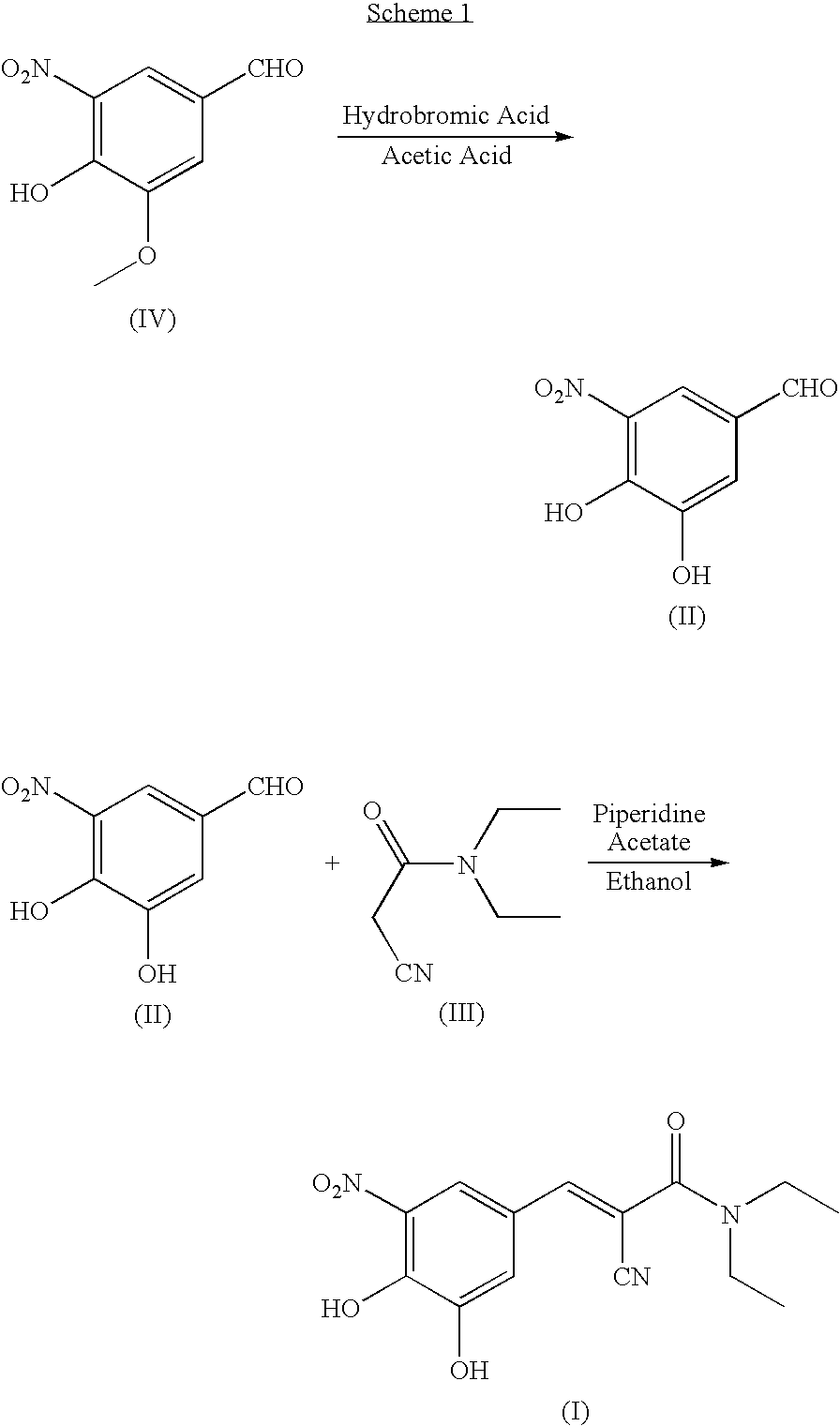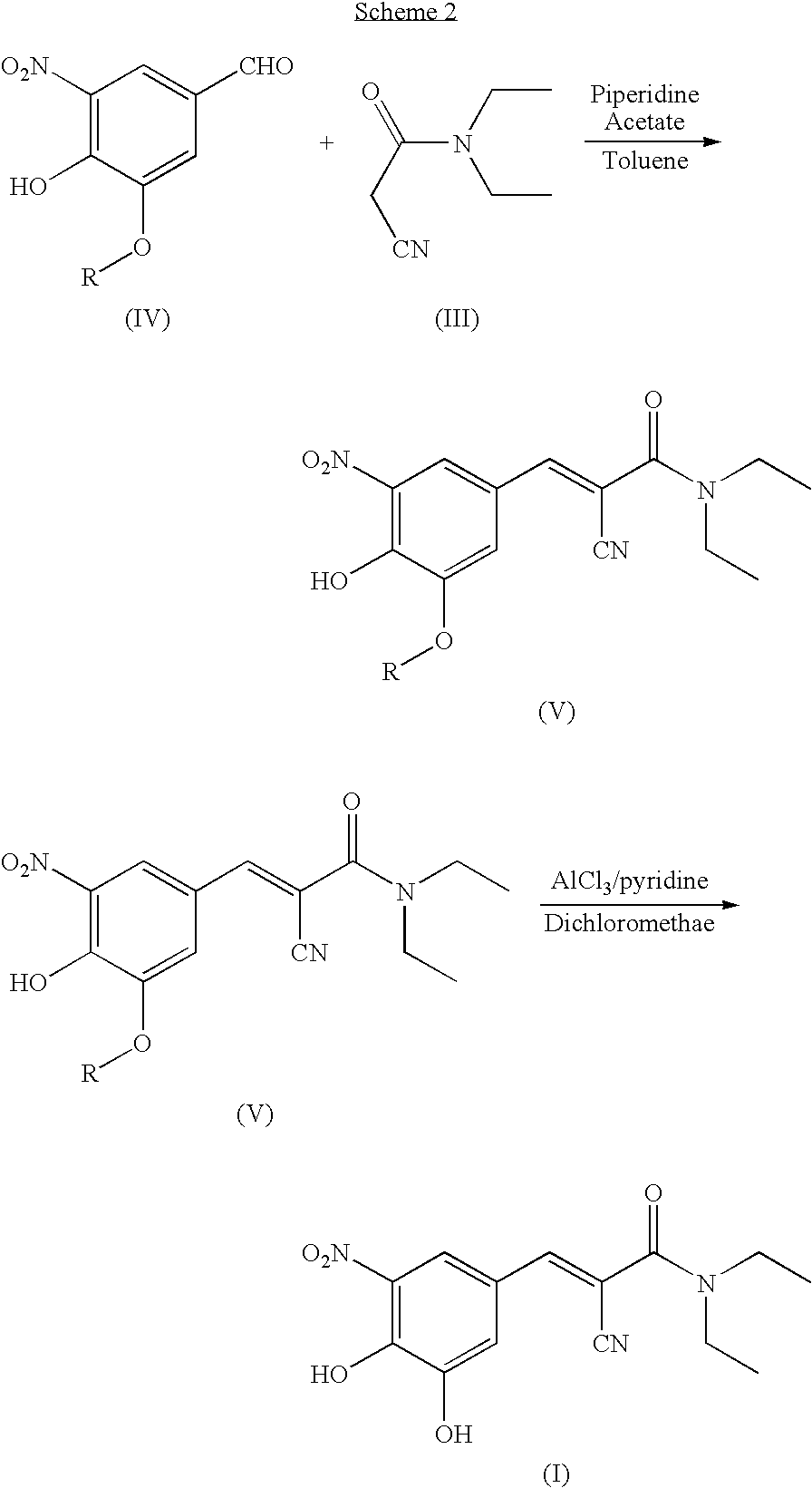Process for the preparation of entacapone
a technology of entacapone and entacapone, which is applied in the field of process for the preparation of entacapone, can solve the problems of excessive reaction time, reaction not going to completion, and yield not very good,
- Summary
- Abstract
- Description
- Claims
- Application Information
AI Technical Summary
Benefits of technology
Problems solved by technology
Method used
Image
Examples
example 1
Preparation of N,N-diethyl-2-cyano-3-(-3-methoxy-4-hydroxy-5-nitrophenyl-)-acrylamide; (V)
[0046]A suspension of 3-methoxy-4-hydroxy-5-nitro-benzaldehyde (100 g, 0.507 mol) in methanol (0.5 1) under nitrogen atmosphere at room temperature, is added with N,N-diethylamino-cyano-acetamide (142 g, 1.01 mol) and a sodium hydroxide solution (30.4 g, 0.761 mol) in methanol (0.5 l). The resulting mixture is reacted under mechanical stirring for 16 hours. After completion of the reaction, a 20% hydrochloric acid solution (0.5 l) is dropped in the mixture which is left to spontaneously cool to room temperature. The resulting product is filtered, washing with water (0.1 l for three times), then dried in the air. 155 g of product are obtained. Yield: 95%.
[0047]1H-NMR (300 MHz), δ (DMS0): 8.10 (d, 1H); 7.85 (d, 1H); 7.70 (s, 1H); 3.40 (m, 4H); 1.15 (m, 6H).
example 2
Preparation of N,N-diethyl-2-cyano-3-(3,4-dihydroxy-5-nitrophenyl)-acrylamide (entacapone); (I)
[0048]A round-bottom flask under nitrogen atmosphere is loaded with N,N-diethyl-2-cyano-3-(-3-methoxy-4-hydroxy-5-nitrophenyl-)-acrylamide (134 g, 0.421 mol) dissolved in dichloromethane (0.65 l) and triethylamine (128 g, 1.26 mol). The solution is cooled to 0-5° C. and aluminium trichloride (67.4 g, 0.505 mol) is added in portions. After that, the mixture is refluxed for 3-4 hours, until completion of the conversion. The reaction mixture is cooled to 0-5° C., a 20% hydrochloric acid solution (0.5 l) is dropped in the mixture, which is left under stirring at room temperature for 30 minutes. The resulting solid is filtered, washing with water (0.1 l×3), and dried in a static dryer under reduced pressure at 50° C.; 126 g are obtained. Yield: 98%.
[0049]1H-NMR (300 MHz), δ (DMS0) 7.90 (d, 1H); 7.75 (d, 1H); 7.60 (s, 1H); 3.40 (m, 4H); 1.15 (m, 6H).
example 3
Purification of N,N-diethyl-2-cyano-3-(-3,4-dihydroxy-5-nitrophenyl-)-acrylamide (Entacapone)
[0050]N,N-Diethyl-2-cyano-3-(-3,4-hydroxy-5-nitrophenyl-)-acrylamide (210 g) in 2-butanone (1.26 l) is loaded into a round-bottom flask under nitrogen atmosphere, and the mixture is refluxed, to obtain complete dissolution. The solution is cooled to 35-40° C. to precipitate the product, then heated again at 60° C. for about 1 h. The mixture is left to cool at room temperature in about 5 hours, cooled to 0-5° C. keeping this temperature for about 1 h, then filtered washing with 2-butanone cooled to 0-5° C. (2×0.15 l). The product is dried in a static dryer at 50° C. under vacuum. 190 g are obtained. Yield: 90%. The product was analyzed according to the procedures reported in U.S. Pat. No. 5,135,950 showing substantially the same physical characteristics as the polymorph A, with (E) stereochemistry, as therein described, with mean (d[4,3]) of about 210 μm.
PUM
| Property | Measurement | Unit |
|---|---|---|
| temperature | aaaaa | aaaaa |
| molar ratio | aaaaa | aaaaa |
| molar ratio | aaaaa | aaaaa |
Abstract
Description
Claims
Application Information
 Login to View More
Login to View More - R&D
- Intellectual Property
- Life Sciences
- Materials
- Tech Scout
- Unparalleled Data Quality
- Higher Quality Content
- 60% Fewer Hallucinations
Browse by: Latest US Patents, China's latest patents, Technical Efficacy Thesaurus, Application Domain, Technology Topic, Popular Technical Reports.
© 2025 PatSnap. All rights reserved.Legal|Privacy policy|Modern Slavery Act Transparency Statement|Sitemap|About US| Contact US: help@patsnap.com



